
The Edward King House, is a monumentally scaled residence at 35 King street in Newport, Rhode Island, United States. It was designed for Edward King in the "Italian Villa" style by Richard Upjohn and was built between 1845 and 1847, making it one of the earliest representations of the style. It was the largest and grandest house in Newport when it was built. Edward King was the largest landowner in town by 1860, having made his fortune through the China Trade.

The Robert Frost House is an historic house in Cambridge, Massachusetts. It consists of four wood-frame townhouses, 2+1⁄2 stories in height, arranged in mirror image styling. Each pair of units has a porch providing access to those units, supported by turned posts and with a low Stick style balustrade. The Queen Anne/Stick style frame house was built in 1884, and has gables decorated with a modest amount of Gothic-style bargeboard. The house was home to poet Robert Frost for the last two decades of his life.
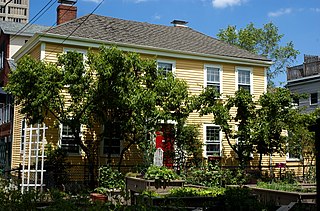
The building at 42 Edward J. Lopez Avenue is a rare Federal period house in East Cambridge, Massachusetts. The two story wood-frame building has a hip roof and very simple styling. It was built about 1830, during the first period of East Cambridge's development after construction of the West Boston Bridge, and was moved to its present location c. 1900, probably as part of construction work in the area. The nature of the terrain in the area at that time means it cannot have been moved very far.

The Building at 10 Follen Street is a historic house at 10 Follen Street in Cambridge, Massachusetts. The three-story wood-frame house was designed by Peabody & Stearns and built in 1875. It is a rare well-preserved example of the transition between Second Empire and Stick styles, with a truncated hip roof, a highly decorated porch, and most of its original interior woodwork.

The E. E. Cummings House is an historic house at 104 Irving Street in Cambridge, Massachusetts. The house was the childhood home of author and poet E. E. Cummings. The Colonial Revival house was built in 1893 for Cummings' parents, and was listed on the National Register of Historic Places in 1983.
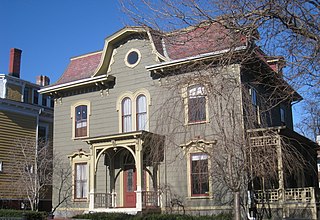
The William R. Jones House is an historic house at 307 Harvard Street in Cambridge, Massachusetts. It is a 2+1⁄2-story wood-frame house, whose Second Empire styling includes a flared mansard roof and flushboarded siding scored to resemble ashlar stone. It has a rare example in Cambridge of a curvilinear front gable, in which is an oculus window. Its windows are topped by heavy decorative hoods, and the porch features square posts with large decorative brackets. The house was built c. 1865 for William R. Jones, a soap manufacturer, and typifies the houses that were built lining Harvard Street in the 19th century after the Dana estate was subdivided.

The Andrew Newman House is a historic house in Cambridge, Massachusetts. It is a 1+1⁄2-story wood-frame structure, five bays wide, with a central chimney and an entrance sheltered by an enclosed vestibule. Built in 1823, this single story wood-frame house is one of the oldest houses in the Cambridgeport area of the city. The house is also unusual for its construction date, since it is a Georgian style Cape house, as opposed to the then-prevalent Federal style. Its first owner was a ropemaker.

The Cheney Read House is an historic house at 135 Western Avenue in Cambridge, Massachusetts, USA. The 2+1⁄2-story wood-frame house was built in 1846 by William Hyde, and is the only house in Cambridge's Cambridgeport neighborhood with a two-story Greek portico. It has four full-height Doric columns, with a gable end that is steeper than the usual Greek Revival style. It has a side-entry plan, with the entrance flanked by pilasters and topped by a pedimented lintel.

The James Nichols House is a historic house in Reading, Massachusetts. Built c. 1795, this 1+1⁄2-story gambrel-roofed house is built in a vernacular Georgian style, and is a rare local example of the style. The house was built by a local shoemaker and farmer who was involved in a religious dispute that divided the town. The house was listed on the National Register of Historic Places in 1984.

The Pierce House is a historic house at 128 Salem Street in Reading, Massachusetts. The 2+1⁄2-story wood-frame house was built sometime between 1875 and 1880 for Samuel Pierce, owner of the nearby Pierce Organ Pipe Factory. The house has Stick style/Eastlake style features, including a steeply pitched gable roof with exposed rafter ends, and an elaborately decorated entry porch with square chamfered columns and brackets in the eaves.

The Edward Gardner House is a historic house at Zero Gardner Place in Winchester, Massachusetts. Built about 1764, it is one of the oldest buildings in Winchester, and is also important for its association with the Gardner family, who were early settlers of the area. It was listed on the National Register of Historic Places in 1989.
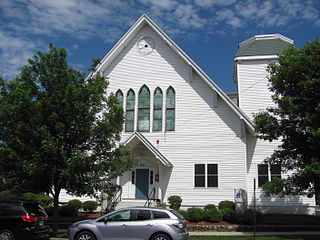
The First Unitarian Church is a historic former church building in Stoneham, Massachusetts. One of Stoneham's more stylish Gothic Revival buildings, the Stick style wood structure was built in 1869 for a Unitarian congregation that was organized in 1858. The building was listed on the National Register of Historic Places in 1984, and included in the Central Square Historic District in 1990. It presently houses the local Community Access Television organization.
Dodge House may refer to:
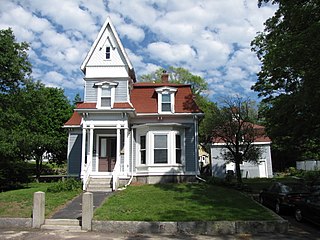
The E. A. Durgin House is a historic house at 113 Summer Street in Stoneham, Massachusetts. The two-story wood-frame Second Empire style house was built c. 1870 for E. A. Durgin, a local shoe dealer, and is one of Stoneham's most elaborately styled 19th century houses. Its main feature is a square tower with a steeply pitched gable roof that stands over the entrance. The gable of the tower is clad in scalloped wood shingles, and includes a small window that is topped by its own gable. The house has a typical mansard roof, although the original slate has been replaced with asphalt shingling, with a cornice that is decorated with dentil molding and studded by paired brackets.
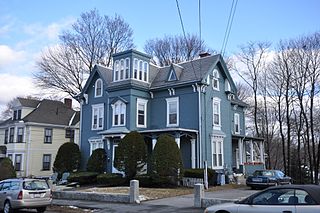
The Charles Wood House is a historic house at 30 Chestnut Street in Stoneham, Massachusetts. It is one of the most elaborate Italianate houses in Stoneham. The 2+1⁄2-story wood-frame house was built c. 1875 for Charles Wood, who lived there until the first decade of the 20th century. Its basic plan is an L shape, but there is a projecting section on the center of the main facade that includes a flat-roof third-story turret, and the roof line has numerous gables facing different directions. There are porches on the front right, and in the crook of the L, with Stick style decorations, the cornice features heavy paired brackets, some of its windows are narrow rounded windows in a somewhat Gothic Revival style, and the walls are clad in several types and shapes of wooden clapboards and shingles.

The House at 7 Salem Street in Wakefield, Massachusetts is a transitional Greek Revival/Italianate style house built c. 1855–57. The 2+1⁄2-story wood-frame house has a typical Greek Revival side hall plan, with door and window surrounds that are also typical to that style. However, it also bears clear Italianate styling with the arched window in the gable, and the paired brackets in the eaves. A single-story porch wraps around the front and side, supported by simple square columns. Its occupant in 1857 was a ticket agent for the Boston and Maine Railroad.

The House at 193 Vernon Street in Wakefield, Massachusetts is a late Federal-style house, built. c. 1840. The 2+1⁄2-story wood-frame house is a rare local example of a three-wide four-deep construction. It has a main entrance on the front facade that has sidelights and a pedimented entablature that were probably added later, and also has a side entrance with a Federal-style transom and sidelights. A late 19th-century barn stands behind the house, a reminder of the area's agricultural use.

The E. C. Hammond House is a historic house at 35 Groveland Street in Newton, Massachusetts. The 1 3/4 story wood-frame house was built in 1909 and designed by its owner, Edward C. Hammond, a lumberman. The house is a simple but well-crafted and preserved example of Craftsman styling. It has a steep gabled roof, with a pergola porch across the front of the main façade. It retains its interior wood work and some original light fixtures.

The Edward Parsons House is a historic house at 56 Cedar Street in Newton, Massachusetts. Built in 1877, this 1+1⁄2-story wood-frame house is an unusual local small-scale example of Stick style. Its gables are decorated with applied wood. The porch is further decorated with chamfered posts, brackets, and rosettes. Nothing is known of its first owner, Edward Parsons, who was listed as a "gentleman" in the local business directory.
Edward Dodge House may refer to:





















